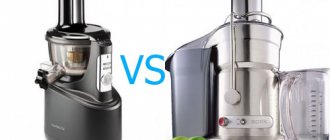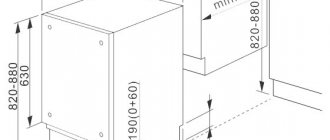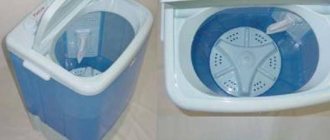Distinctive features
A number of distinctive features can be identified:
- the manufacturer has equipped the equipment with inverter motors, ensuring high performance and silent operation;
- dishwashers are powered by instantaneous water heaters, which increases the efficiency of washing dishes and ease of use;
- the equipment is equipped with innovative options;
- Dishwashers are distinguished by modern design, precision processing and clear lines.
About
Types of devices
Siemens dishwashers come in three types:
- built-in;
- partially built-in;
- free-standing.
Regardless of the type of dishwasher, they provide high-quality results, washing dishes to a mirror shine.
When choosing a dishwasher, you should pay attention to the dimensions and capacity of the equipment. These criteria will allow you to select a unit that suits its characteristics and cost.
Fully built-in
The main advantage of a built-in dishwasher is that you can hide the equipment behind the façade of the kitchen unit without compromising the integrity of the interior.
The models are suitable for families with small children, since the door is locked in operating mode and the child will not be able to press the buttons. Another important point is that due to the additional frame on all sides, the operation of the machine is practically inaudible.
Partially built-in
The brand's line includes compact dishwashers - partially built-in appliances in which the front panel is not covered by the cabinet facade.
The models are laconic and take up less space, so they are suitable for rooms with small footage. You can hide the machine in a niche or under a countertop.
Freestanding
The main advantage of a free-standing dishwasher is mobility. This technique will not spoil the interior, especially if the renovation is done in a high-tech style.
Models are often purchased when the kitchen is fully equipped and there is no way to redo anything. If you have free space, you can place the machine in any place convenient for connecting communications.
About
Dishwasher device and operating principle. How a dishwasher works
Unfortunately, many people do not understand what the operating principle of a dishwasher (hereinafter also referred to as dishwashers, PMM) is. This is why there is a common misconception that household appliances are not capable of washing dirty dishes better than human hands.
Anyone who has ever tried to wash dishes in a dishwasher will no longer want to do it with their hands.
Users are confused by the fact that the dishes are simply sprayed with water with detergent dissolved in it and are not subjected to mechanical stress. Many housewives do not believe that this is how they can wash spoons, forks and plates with dried food residues. In fact, this is not the case at all. We will try to dissuade skeptics and tell you how a dishwasher works and works.
How does a dishwasher work?
Before readers become acquainted with the principle of operation of the PMM, its structure should be described.
Many people believe that dishwashers are complex and capricious devices. There really isn't much detail in them. Before we look at them, familiarize yourself with what you will see when you open the dishwasher door for the first time (see picture).
Diagram of the approximate location of parts in the basket and front door of the PMM
The main parts are located inside the lower part of the dishwasher body and are invisible to the human eye. They can be divided into three main groups:
- electronic control module – the brain of the entire device;
- sensors that supply the necessary information to the control module for analysis;
- actuators.
Based on the schematic diagram presented below, the dishwasher consists of the following components and parts:
- The upper basket in which dishes are placed.
- Return spring that closes the door.
- Upper and lower sprinklers.
- Thermal relay with water temperature sensor.
- Coarse and fine filters.
- Drain hose leading into the sewer.
- Safety valve that is activated when the pressure is exceeded.
- Drain pump that removes dirty water into the sewer.
- A reservoir into which water is collected.
- One of the parts of the Aquastop protective system, which prevents flooding in emergency situations.
- Control module.
- A circulation pump that pumps liquid into the spray nozzles and further along the circuit while washing dishes.
- Capacitor.
- A dispenser into which the rinse aid is poured.
- A lock that blocks the door.
- A dispenser into which detergent is poured or poured.
- Inlet valve that controls the water supply to the dishwasher.
- Seal that frames the door.
- The lid of the container where the sodium salt is poured.
- An electric heater that brings water to the desired temperature.
- The inlet hose through which water flows into the PMM.
- Rollers with guides along which baskets with dishes move.
Advantages and disadvantages
If you look at customer reviews, among the main advantages that a Siemens brand dishwasher has are the following:
- simple installation of equipment under the countertop;
- dishwashers are equipped with innovative options;
- You can move containers in the chamber to accommodate all the necessary utensils. The manufacturer also offers special boxes that can be used for large loads of glasses;
- Dishwashers efficiently wash dirt of any complexity;
- Dishes dry quickly thanks to condensation drying;
- high build quality;
- The equipment is quite easy to use.
The main disadvantage is the high price. Some models do not have an indication of the time remaining until the end of the cycle, an audible signal, or a half load.
About
How to choose and what to pay attention to?
The range of dishwashers includes dozens of models with different designs and functionality. To choose the most suitable equipment, you should pay attention to a number of criteria before purchasing a machine.
Dimensions and capacity of the camera
The larger the dishwasher, the more dishes it will fit.
Taking into account the dimensions, three types of machines can be distinguished:
- full-size - 60 cm wide and 80-82 cm high, with a capacity of 12-14 sets of dishes;
- narrow - a model with a width of 45 cm, holds up to 10 sets of dishes;
- mini dishwashers - models with a height of 45-60 cm, capable of washing up to 8 sets of dishes in one cycle.
One set of dishes includes a plate for the first and second courses, a cup and saucer, a glass, a spoon, a fork and a knife. The capacity should be chosen keeping in mind the family members. For 1-2 people, a compact model with a width of 45 cm is quite suitable.
Technical potential and functions
Siemens dishwashers are a combination of advanced technologies and innovative options that provide high-quality results, convenient operation and economical consumption of resources. The machines are equipped with drying and other useful options.
Zeolith drying technologies
This is a dish drying technology that has no analogues among competitors. The operating principle is based on the mineral zeolite, which absorbs liquid and transforms it into heat. The container with the mineral is located at the bottom of the chamber.
During the washing process, heat is used to heat water, and during the drying stage it is transferred into the chamber in the form of dry air. There is no need to change the mineral, as it is self-healing.
iQdrive inverter motor
The engine is the main element of the dishwasher , responsible for the quality of work and the amount of resources consumed.
Cars from Siemens are equipped with iQdrive inverter motors, thanks to which the equipment belongs to the elite class. The motor ensures silent operation and economical consumption of resources.
AquaStop and AquaSensor technologies
AquaStop is a two-stage mechanism for complete protection against leaks throughout the entire service life of the machine. If a leak occurs, the water supply valve is blocked. If a leak occurs in the drainage system, the liquid pumping option is activated.
AquaSensor is a technology aimed at economical water consumption. If the waste water then meets the standards, it is reused.
IntensiveZone and VarioSpeed+ cleaning functions
IntensiveZone is a mode in which the machine simultaneously washes dishes of varying degrees of soiling and strength. In the lower part of the chamber, the temperature and water pressure are higher - this area is suitable for placing pots and pans. In the upper part there are fragile dishes that are washed in a gentle mode.
VarioSpeed+ is an accelerated operating mode. When selecting this function, the cycle is shortened by 30-50%. The unit independently regulates water pressure and the number of rinses. This mode is not suitable for fragile dishes.
Water monitoring technology
Dishwashers are equipped with an OptoSenser option that monitors the condition of the water. Thanks to special sensors, the device notifies users about the amount of lime and calcium suspension, as well as the need to use regeneration salt. Thanks to this technology, water is softened, protecting dishes and equipment parts.
Additional options
In addition to the listed functions and technologies, some dishwashers have additional options for more convenient operation of the equipment:
- a program with temperatures up to 70° , necessary for washing cutting boards and children's dishes;
- delayed start - this option is available in most dishwashers; you can load the dishwasher and delay its operation for several hours;
- child lock - a necessary part that is found in only a few models; the control panel is locked so that children cannot change the program;
- DossageAssist - a compartment for tablet detergents, eliminating the risk of a tablet getting stuck between dishes;
- GlasschonSystem and BrilliantShine are technologies aimed at delicate glass cleaning at low temperatures and medium water hardness levels.
About
How does a dishwasher work?
Before you start using the washing machine in the kitchen, it must be connected to communications: power supply, water supply and sewerage. Mostly, this work is performed by craftsmen, but if you have the tools and skills, you can connect the PMM yourself. You can read how to do this here.
To operate the dishwasher, the following consumables are required:
- specially prepared salt to soften water (remove salts from it);
- detergent;
- rinse aid
Using a special type of salt that softens water is a necessary condition for high-quality dishwashing. When using tablets that combine all three components, salt is still added to the container.
Consumables for dishwashersSo, let's look at the operating principle of a dishwasher. Its work occurs in several stages:
- Dirty dishes are loaded into baskets located in the working chamber. It should be noted that the dishes must be placed strictly according to the rules, otherwise they will not be washed properly.
- The machine is turned on and its operating program is selected. For example, for kitchen utensils that are too dirty, a pre-soaking mode is selected, as well as a high water heating temperature.
- Through the inlet hose and inlet valve, water begins to flow into the designated reservoir. The liquid is mixed with salt and softened. At the same time, the water is heated to the temperature specified by the program. Some models of household appliances from Bosch, Siemens, Electrolux and other well-known manufacturers have the ability to connect not only to cold, but also to hot water. Despite this, experts do not recommend connecting hot water, since the PMM will still heat it itself.
- Once the liquid has reached the desired temperature, it is mixed with detergent and the pre-soak cycle begins. The circulation pump supplies the mixture in small portions to the sprinklers (hereinafter also referred to as sprayers). Under liquid pressure, the sprayers begin to rotate and distribute the washing mixture through the nozzles over the entire surface of the dirty dishes. Water softens dried food residues. Once this task is completed, the primary rinse mode is activated. The pump intensively supplies liquid to the nozzles. Under the influence of strong pressure, most of the soggy dirt residues are washed off from the kitchen utensils.
- The dirty liquid is not drained down the drain, but passes through a filter, being cleaned for reuse. This allows you to save resources. Detergent is added again to the purified water. A more concentrated mixture is again sprayed over the surface of the dishes in a large volume, completely washing away the remaining dirt. Only after reuse is the dirty liquid drained into the sewer using a pump.
- For the final rinsing of the kitchen utensils, the inlet valve is opened again and clean water is drawn into the reservoir. First, the container is rinsed with a small amount of it, and then the reservoir is filled for the final stage. The drainage pump delivers liquid under high pressure to the spray nozzles, which allows you to completely wash away any remaining detergent and dirt. Depending on the selected program, rinsing can be carried out once or twice. After the process is completed, the drain pump removes the waste water into the sewer.
- The final stage is drying the washed dishes. Depending on the design of the PMM, kitchen utensils are dried forcibly or in a natural (convection) mode. The forced option provides that heated air is pumped into the chamber and quickly dries the dishes. Natural drying takes longer.
Forced turbo drying in dishwashers
Now you know how PMM washes dishes. As you can see, there is nothing complicated about this. The main feature is that hot soft water, diluted with a detergent, can wash away even the oldest and most dried dirt.
We invite you to see with your own eyes from the inside what happens in the dishwasher chamber when it is working:
Dishwashers are increasingly winning the hearts of buyers in Russia and neighboring countries. As you can see, anyone can handle their maintenance, and the benefits and time savings are enormous.









